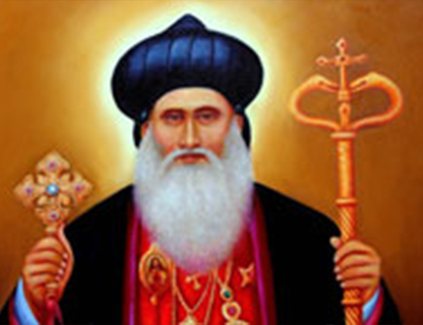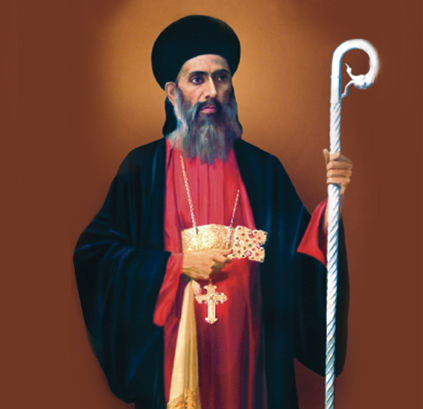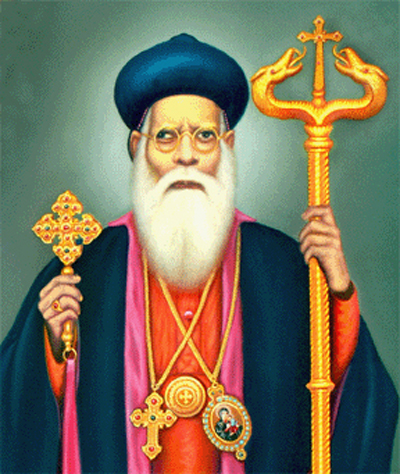
St Baselios Yeldho was born in a village called kooded (now known as Karakosh) near Mosul in Iraq where Marth Smooni and her 7 children suffered martyrdom. At a very young age he joined the Mar Bahanan Monastery and become a monk. In 1678 he was consecrated Maphriyana by the Patriarch of Antioch Moran Mar Ignatius Abdul Masiha I. In 1685 at the age of 92, the holy father started the difficult mission to India at the request of Mar Thoma II of Malankara who informed the Patriarchate about the unpleasant situation of the Church here.
The saintly Maphriyana was accompanied by Mar Ivanios Hidayathulla, his brother and two monks but only three of them is believed to have reached Malankara. As the saint reached the church premises, the church bells began to toll. People living in the neighbourhood rushed to the church to find out what the commotion was about. And that was on ‘Kanni 11th’ in the Malayalam calendar (end of September), AD 1685. The Saint entered the church and sat on the steps of the ‘Madbaha’. There was a young deacon who was fluent in Syriac. When he realized that a Episcopa had stayed behind at Kozhipally, he and some members of the congregation set out for the place. They took a kerchief from the Saint for identification. When the Episcopa saw the approaching crowd he was afraid. He thought that they had killed Bava and were now about to get at him. He therefore refused to come down from the tree. The deacon however offered him the sign of peace and spoke Syriac. He then came down from the tree and went with the people to the church. On Kanni 13, the church used to celebrate its foundation day. On the 12th evening the Vicar sought the Saint’s permission to hoist the flag. The Saint replied that the festival of the Holy Cross should be celebrated on the 14th and not on the 13th. When it was explained to the Saint that what they were celebrating was not the festival of the Holy Cross but the anniversary of the founding of the parish, the Saint permitted them to go ahead but reminded them about the importance of the festival of the Holy Cross. On the next day, on the feast of the Holy Cross, (‘Kanni 14’ as per the Malayalam calendar), Episcopa Mar Ivanios Hidayathulla was consecrated as Metropolitan after the Qurbana by the saintly Mar Baselios Yeldho Bava. (Mar Ivanios, who was consecrated by Mar Yeldho, carried on apostolic work for eight years. He passed away in 1693 and was buried at the Mar Thoman Church, Mulanthuruthy). Because of the tedious journey and the old age, Bava was totally exhausted by then. Three days after he became seriously ill. On Kanni 17th, he received the last sacraments of anointment with oil and extreme unction. All the while he was lying inside the church. Two days after (on Kanni 19, which is September 29) in the afternoon, the saintly father left his mortal self for his heavenly home at the age of 92. That was a Saturday. As he was sinking, the congregation assembled inside the church and were offering prayers. The Saint told them that he was about to die and when his spirit leaves his body, there would be a sign on the Cross situated on the western side of the Church. And the huge granite Cross miraculously lit up at the time of the Saint’s demise. The Holy Father’s mortal remains was entombed on the next day (Kanni 20) in the western side of the Madbaha of the church. The two weeks of sojourn of the Maphriyana at Kothamangalam electrified the Marthoma Christians all over Malankara and the mission undertaken by the saint was fulfilled to a large extent by his faithful associate, Metropolitan Mar Ivanios Hidayathulla. In 1947 Mar Baselios Yeldho of blessed memory was declared a saint by the then Catholicos of the church, His Holiness Baselius Geevarghese II.

Saint Gregorios of Parumala is popularly known as ‘Parumala Thirumeni’. Metropolitan Geevarghese Mar Gregorios of the Malankara Orthodox Church who passed away on November 2nd 1902, became the first declared saint from Malankara (Kerala, India) naturally to be called, ‘Parumala Thirumeni’. He shines in the cloud of witnesses as a bright luminary giving rays of hope to millions in their suffering and struggles.
Mar Gregorios was born on 15th June 1848 (M.E. Mithunam 3, 1023) to Kochu Mathai and Mariam of Pallathetta family in the Chathuruthy house at Mulamthuruthy. He was called by the name ‘Kochaippora’ and was given the baptismal name ‘Geevarghese’. Kochaippora had two brothers and two sisters; Kurian, Eli, Mariam and Varkey. Kochaippora was the youngest and was therefore the most beloved to everyone. Unfortunately, his mother passed away when he was only two years old. His eldest sister Mariam became to him all that a mother was meant. Mariam was married at that time and had a child of Kochaippora’s age.
He was ordained as a reader-deacon (Korooyo) on 14th Sept, 1858 at the age of ten by Palakkunnath Mathews Mar Athanasios at Karingachira Church. Koroyo Geevarghese continued his training under Geevarghese Malpan until the latter died due to small pox. Although Deacon Geevarghese was also infected with small pox, he miraculously survived it. Afterwards Deacon Geevarghese moved to Pampakuda to continued his studies under Konat Geevarghese Malpan. In the mean time Deacon became associated with the visiting Syrian Bishop Yuyakim Mar Coorilos. Mar Coorilos had great admiration for the deacon and was pleased to ordain him as full deacon, priest and cor-episcopa within few months in 1865.
He was ordained as a reader-deacon (Korooyo) on 14th Sept, 1858 at the age of ten by Palakkunnath Mathews Mar Athanasios at Karingachira Church. Koroyo Geevarghese continued his training under Geevarghese Malpan until the latter died due to small pox. Although Deacon Geevarghese was also infected with small pox, he miraculously survived it. Afterwards Deacon Geevarghese moved to Pampakuda to continued his studies under Konat Geevarghese Malpan. In the mean time Deacon became associated with the visiting Syrian Bishop Yuyakim Mar Coorilos. Mar Coorilos had great admiration for the deacon and was pleased to ordain him as full deacon, priest and cor-episcopa within few months in 1865.
In 1875, the Antioch Patriarch His Holiness Peter III visited Malankara. The Patriarch chose Ramban Geevarghese as his Secretary and translator during the entire visit. Along with the Patriarch , the Ramban visited many churches. Ramban Geevarghese also assisted the Patriarch in the consecration of the Holy Mooron and in the historic synod of Mulanthuruthy in 1876.
Being pleased with the Ramban Geevarghese, the Patriarch decided to consecrate him as Metropolitan. On December 10, 1876 the Patriarch consecrated six priests as bishops including Ramban Geevarghese at St. Thomas Church, N Paravur. He was given the new name Geevarghese Mar Gregorios and was given the charge of Niranam Diocese.
The other bishops and their Diocese were:
Murimattath Mar Ivanios (Kandanad)
Kadavil Mar Athanasios (Kottayam)
Ambattu Mar Coorilos (Ankamaly)
Karottuveetil Simon Mar Dionysius (Cochin)
Konat Mar Julius (Thumpamon).
Mar Gregorios was only 28 years when he was made a bishop. Since he was the youngest among all the bishops, he was dearly called by all as ‘Kochu Thirumeni’. The first thing the new bishops undertook was a special fasting-vigil for forty days at Vettickal Dayara under the leadership of ‘Kochu Thirumeni’. This fasting was both symbolic and effective in the pursuit of new life in an old church.
Mar Gregorios took charge of the Niranam Diocese and started staying at Parumala. There was at Parumala, at that time, a land donated by Arikupurath Koruth Mathen to the church and in this plot a small building was erected by the Malankara Metropolitan Pulikkottil Joseph Mar Dionysius. This building was known as ‘Azhippura’. Mar Gregorios lived there along with few other deacons who came for priestly training. They worshipped in a thatched chapel during that time.
Mar Gregorios engaged in a threefold activity of tireless service for the church: Diocesan administration, Ministerial formation of deacons, Missionary witness of the church through inner spiritual and theological consolidation, along with evangelical reaching out. In addition to these, Mar Gregorios undertook the task of building a church and seminary at Parumala. The diocesan administration, in the mean time, was extended to two more dioceses, Thumpamon and Quilon. The newly constructed church was consecrated in 1895. Mar Gregorios was the co-celebrant for the consecration of two ex-Roman Catholic priests as bishops: Fr.Alvaris as Alvaris Mar Kulius for Bombay-Mangalore Diocese; Fr.Rene Vilatti as Rene Vilatti Mar Timotheos for America. out.
Mar Gregorios made the Holy Land Pilgrimage in 1895 as the fulfillment of a long cherished dream. On his return he published a travelogue under the title ‘Oorslem yathra vivaranam’ (a narrative of the Jerusalem visit). This book, published in 1895 is to be considered as the earliest printed travelogue in Malayalam. This book had its centenary edition in 1996 and translation into English in 2000.
Mar Gregorios believed that the church should engage in educational activity especially to facilitate primary education and English teaching without discriminating gender or religion. Accordingly he started schools at Kunnamkulam, Mulamthuruthy, Niranam, Thumpamon, Thiruvalla etc. The missionary task of the Church was also evinced by his outreach programme to the socially down trodden communities at Chennithala, Kalikunnu, Mallappally, Puthupally, Kallumkathara etc. He also organized evangelical awakening programme for non-Christians at various places like Aluva, under the leadership of the Seminary students. A major task of Mar Gregorios was to motivate the clergy for effective ministry. With this aim, he formed the Malankara Syrian Clergy Association and took many progressive decisions and made many suggestions for the effective functioning of the priestly ministry.
A major task of Mar Gregorios was to motivate the clergy for effective ministry. With this aim, he formed the Malankara Syrian Clergy Association and took many progressive decisions and made many suggestions for the effective functioning of the priestly ministry.
Among the many disciples of Mar Gregorios, three deserve special notice:
1. Vattasseril Rev.Fr.Geevarghese (later, Malankara Metropolitan Geevarghese Mar Dionysius)
2. Kuttikattu Rev.Fr.Paulose (later, Paulose Mar Athanasios of Aluva)
3. Kallasseril Rev.Fr,Geevarghese (Punnoose) (later, Catholicos Baselios Geevarghese II)
The blessed soul left the earthly abode on 2nd November 1902. The funeral was conducted at Parumala on Tuesday the 3rd of November 1902 in the presence of thousands of people and hundreds of priests. The many testimonies to the saintly intercession of Mar Gregorios made Parumala Church and the tomb a centre of pilgrimage. In 1947 Mar Gregorios of blessed memory was declared a saint by the then Catholicos of the church, His Holiness Baselius Geevarghese II.

St. Geevarghese Mar Dionysius Vattasseril, Malankara Metropolitan, was a bright light for the Malankara Orthodox Syrian Church that illumined during her dark and tumultuous times and possessed the vision to bring the Church triumphantly from the bonds of foreign oppression. Thirumeni dedicated his entire life to secure the freedom and welfare of the Holy Church. His Grace faced many troubles and obstacles as well as received constant physical and verbal abuse via threats and physical attacks as he courageously led the Church to her independence. He confronted the dangers and obstacles directly responding with vigor, strength and remarkable conviction and confidence in God's justice and plan, which was a product of his continual fasting and prayer. God protected Thirumeni throughout his life whether in Kerala or abroad as he sought the freedom of the Church from foreign powers. His great triumph lay in the ability to unite the entire Church, both the priests and laymen to follow his lead. He was incredibly gifted in many fields, a multifarious genius. He was a spiritual leader, a theological educator, scholar of languages, literature and traditions. He was a dignified, valorous and noble personality with a remarkable commanding power.
St. Dionysius was born to his parents, Joseph Vattasseril of Mallappally and Eliamma Kolathu Kalathil of Kurichy on 31st October 1858. Following his elementary education at C. M. S. Middle School in Mallappally he completed his high school education from C. M. S. High School, Kottayam. In 1876, while still a high school student, he was ordained as a sub deacon by H. H. Moran Mar Pathrose Patriarch.
Dn. Geevarghese studied at the Orthodox Theological Seminary (Old Seminary or Pazhaya Seminary), Kottayam for four years thereby undergoing his theological training. Dn. Geevarghese soon became a great Syriac scholar under the careful tutelage of St. Gregorios of Parumala, who taught him at Seminary. In 1879 Dn. Geevarghese was ordained as a full deacon and in 1880 he was ordained as a priest by St. Gregorios. By 1880, Fr. Geevarghese had become an authority in the Syriac, Church History, Faith and Doctrine, the Church Fathers, and Theology. In recognition of his incredible expertise in Syriac and theology he was designated as Malankara Malpan. He spent his spare time reading, studying, and thinking which translated to his many renowned writings such as "Doctrines of the Church". He also used his scholarship to edit and publish the order of Church worship to be used by the ordinary faithful for meaningful participation in worship. He was appointed as Principal of M. D. Seminary, Kottayam as he was both a great scholar and administrator. In 1903, he was blessed as a Ramban (monk). He also served as the Manager of Parumala Seminary. In 1908 he was consecrated as H. G. Geevarghese Mar Dionysius Metropolitan and served as the Assistant Malankara Metropolitan. The next year he became the Malankara Metropolitan and served and led the Church in that capacity until his departure from this life in 1934 when he and the Church triumphed in establishing the official constitution of the Malankara Orthodox Syrian Church.
H. H. Moran Mar Baselios Geevarghese II Catholicos of blessed memory remarked in the speech at the burial of Vattasseril Thirumeni, "When we look at the highest solemn position held by Vattasseril Thirumeni and his deep and firm faith in God, he seemed similar to Moses who led the sons of Abraham from the captive land of Egypt to the promised land of freedom and happiness. There is no doubt about it. Moses had spent his entire life for the freedom of his people but he could not enter the Promised Land. He was only able to see the Promised Land from a distance. Likewise the Moses of the Malankara Church has also watched the freedom of his Church from a distance". Vattasseril Thirumeni was a good orator who was well aware of the importance of the vitality and moral persuasiveness of words when delivering the speeches to the faithful. Spiritually, he was transformed by Christ and bore no scars from sin. His humility and withdrawal from the praise of this world kept many from seeing the incredibly pious and faithful life that Thirumeni lived. In addition to not publicizing his own spiritual advancement he also avoided spiritual hypocrisy and arrogance throughout his life. Prayers and fasting were the pillars that were Vattasseril Thirumeni's spiritual foundation. He faced all the challenges with the power he had gained through his valued spiritual life. In addition to the liturgical hours of prayer, Thirumeni spent much time in private prayers and silent meditations behind closed doors and away from the attention of people. In spite of his busy schedule, he was also able to focus on three to four lessons from the Holy Bible everyday. Despite Vattasseril Thirumeni's literal application of Christ's instruction to pray in private and not for others to see, many recognized that His Grace was a living saint amongst them.